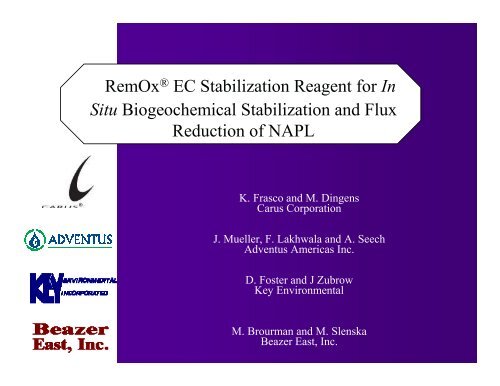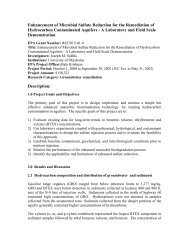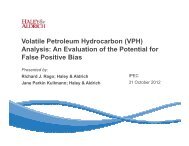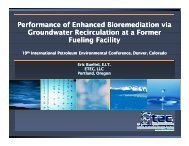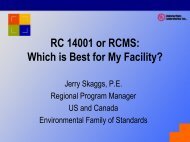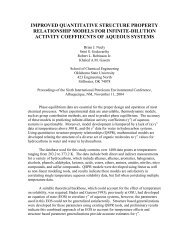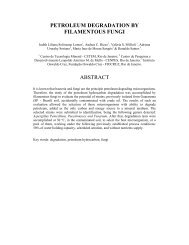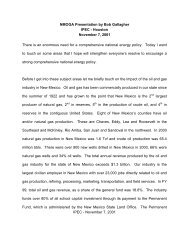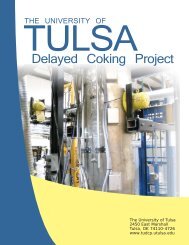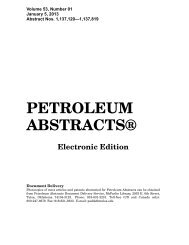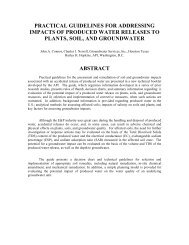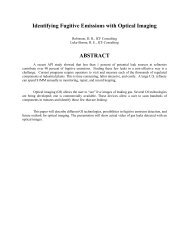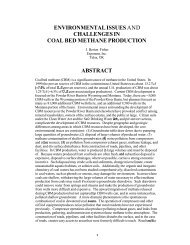RemOx® EC Stabilization Reagent for In Situ Biogeochemical - IPEC
RemOx® EC Stabilization Reagent for In Situ Biogeochemical - IPEC
RemOx® EC Stabilization Reagent for In Situ Biogeochemical - IPEC
Create successful ePaper yourself
Turn your PDF publications into a flip-book with our unique Google optimized e-Paper software.
RemOx ® <strong>EC</strong> <strong>Stabilization</strong> <strong>Reagent</strong> <strong>for</strong> <strong>In</strong><br />
<strong>Situ</strong> <strong>Biogeochemical</strong> <strong>Stabilization</strong> and Flux<br />
Reduction of NAPL<br />
K. Frasco and M. Dingens<br />
Carus Corporation<br />
J. Mueller, F. Lakhwala and A. Seech<br />
Adventus Americas <strong>In</strong>c.<br />
D. Foster and J Zubrow<br />
Key Environmental<br />
M. Brourman and M. Slenska<br />
Beazer East, <strong>In</strong>c.
The Challenge<br />
Primary Sources - Excavation and Disposal<br />
$100 to $250/yd 3<br />
Secondary Sources – More Challenging<br />
>$250/yd 3
What is <strong>In</strong> <strong>Situ</strong> Bio-Geochemical<br />
<strong>Stabilization</strong> (ISBS)?<br />
<strong>In</strong> situ biogeochemical stabilization (ISBS)<br />
describes an emerging remedial<br />
technology that entails the use of a<br />
modified permanganate based solution<br />
called RemOx ® <strong>EC</strong> <strong>Stabilization</strong> <strong>Reagent</strong>.
ISBS Technology Specifics<br />
• Encapsulation of the contaminant(s) of concern<br />
• Flux reduction of the aquifer<br />
• Limited mass destruction<br />
• Enhanced bioremediation after the stabilization<br />
is complete
Technology Development<br />
1997 - Conceptualization<br />
1998 – 2000 Proof of Concept R&D at UW and Adventus<br />
2000 - 2001 Pilot studies Camp Borden<br />
2002 - 2003 Phase I Pilot Denver<br />
2004 - Phase II Full Scale Denver; Bench testing Gainesville<br />
2005 - MGP NE Utilities; New ISBS <strong>Reagent</strong>s (patent<br />
pending)<br />
2006-Present – Licensed to Carus as RemOx <strong>EC</strong>; Field<br />
implementation in Alabama, Florida; Others pending
This work piqued our interest in the technology
SEM DATA<br />
Soil Treated with<br />
RemOx ® <strong>EC</strong><br />
Untreated Soil
Birnessite is an oxide of Mn and Mg<br />
along with Na, Ca and K with the composition:<br />
(Na,Ca,K)(Mg,Mn)Mn 6 O 14 .5H 2 O
Longevity of (X)FeMnO 2<br />
Mars Blueberries<br />
Petroglyphs
Crust Longevity<br />
• Kinetic geochemical<br />
modeling suggest<br />
crust life ~ 400 years<br />
(> 2,000 pore-volume<br />
flushes).<br />
• This may be overestimated<br />
because it<br />
assumes Eh (-700 mV)<br />
and pH (11)<br />
More soluble<br />
Eh-pH diagram from Hem (1985)
Denver, CO Site
Previous NAPL Recovery Ef<strong>for</strong>ts<br />
• Approximately 6,300 gal residual NAPL<br />
• Manual bailing (< 200 gal)<br />
• Low-flow skimmer pumps (< 10 gal)<br />
• 800-ft long recovery trench (< 55 gal)
5 g/kg vs. 18 g/kg NOD
Denver, CO Site
Soil Sample Prior to Treatment<br />
With RemOx® <strong>EC</strong><br />
Soil Treated With<br />
RemOx® <strong>EC</strong><br />
Samples taken from same depth three feet apart
Mass Removal<br />
COI (mg/kg) Average (n=4) Average (n=4) %<br />
Background Treated Reduction<br />
LMW PAHS 7,633.50 5,996.75 21<br />
HMW PAHs 1,961.55 1,744.55 10<br />
TOTAL PAHs 9,595.05 7,771.30 19<br />
* PENTA 236.00 55.67 76<br />
* TOTAL CPs 284.48 59.25 79<br />
* Excludes sample IB05A-14 to 14.5 ft bgs (80 v. 8 ppm dppenta + 296 ppm total penta)
Flux Reduction<br />
COI (mg/L) Average Average %<br />
Background Treated Reduction<br />
LMW PAHS 34.41 12.75 73<br />
HMW PAHs 6.05 0.11 99<br />
TOTAL PAHs 40.46 12.86 79<br />
* PENTA 18.91 9.66 49<br />
* TOTAL CPs 23.38 10.41 56<br />
* Excludes sample IB05A-14 to 14.5 ft bgs (80 v. 8 ppm dppenta + 296 ppm total penta)
Woodward Coke Site –<br />
Alabama<br />
• Former Coke plant demolished in 1998<br />
• Coke/coal fines are present near surface over a large<br />
portion of the site underlain by clay residuum and<br />
dolomite with karst related features (e.g. solution voids)<br />
• Localized areas of NAPL- impacted soil and<br />
groundwater are present<br />
• Higher dissolved phase concentrations correlate with<br />
presence of NAPL/Tar
• Fracture zone between 28<br />
and 30 ft bgs<br />
• Sample from fracture zone<br />
well indicated BTEX (473<br />
ug/L), Naphthalene (5,000<br />
ug/L) and other PAHs<br />
(2,500 ug/L)<br />
• Groundwater TOC (10.3<br />
mg/L) consistent with<br />
expected COI<br />
concentrations<br />
• Soil NOD testing indicates<br />
low oxidant demand (1.5 to<br />
1.6 mg/L KMnO 4<br />
)<br />
RemOx <strong>EC</strong> Area M-65R/B
10 Day Column<br />
SVOCs in Leachate<br />
(ppb)<br />
ISBS<br />
Treatment<br />
Control<br />
Naphthalene<br />
9.55<br />
58<br />
• 1% RemOx <strong>EC</strong><br />
Solution<br />
2-Methylnaphthalene<br />
Acenaphthylene<br />
Acenaphthene<br />
2.35<br />
ND (1.0)<br />
ND (1.0)<br />
16<br />
ND (0.93)<br />
ND (0.93)<br />
• 85% Reduction in<br />
SVOC concentrations<br />
in column leachate<br />
Dibenzofuran<br />
Phenanthrene<br />
Anthracene<br />
Fluoranthene<br />
0.405<br />
ND (1.0)<br />
ND (1.0)<br />
0.195<br />
2.70<br />
1.10<br />
ND (0.93)<br />
1.30<br />
Pyrene<br />
ND (1.0)<br />
0.45<br />
Benzo(a)anthracene<br />
ND (0.20)<br />
ND (0.19)<br />
Chrysene<br />
ND (0.50)<br />
0.45<br />
Benzo(b)fluoranthene<br />
ND (0.20)<br />
0.72<br />
Benzo(k)fluoranthene<br />
ND (0.20)<br />
ND (0.19)<br />
Total SVOC<br />
12.50<br />
80.72
10 Day Column<br />
SVOCs in Leachate<br />
(ppb)<br />
ISBS<br />
Treatment<br />
Control<br />
Naphthalene<br />
9.55<br />
58<br />
• 1% RemOx <strong>EC</strong><br />
Solution<br />
2-Methylnaphthalene<br />
Acenaphthylene<br />
Acenaphthene<br />
2.35<br />
ND (1.0)<br />
ND (1.0)<br />
16<br />
ND (0.93)<br />
ND (0.93)<br />
• 41% Reduction in<br />
SVOC soil<br />
concentrations<br />
Dibenzofuran<br />
Phenanthrene<br />
Anthracene<br />
Fluoranthene<br />
0.405<br />
ND (1.0)<br />
ND (1.0)<br />
0.195<br />
2.70<br />
1.10<br />
ND (0.93)<br />
1.30<br />
Pyrene<br />
ND (1.0)<br />
0.45<br />
Benzo(a)anthracene<br />
ND (0.20)<br />
ND (0.19)<br />
Chrysene<br />
ND (0.50)<br />
0.45<br />
Benzo(b)fluoranthene<br />
ND (0.20)<br />
0.72<br />
Benzo(k)fluoranthene<br />
ND (0.20)<br />
ND (0.19)<br />
Total SVOC<br />
12.50<br />
80.72
• MW-65B<br />
• Screened 21-31 ft bgs<br />
• DTW ca. 8 to 12 ft bgs<br />
• Historical DNAPL in<br />
fractured dolomite @ 25<br />
to 30 ft bgs
3 <strong>In</strong>jection Points<br />
2 Extraction Points<br />
MW-04<br />
IW-05<br />
Water Storage Tank<br />
IW-01<br />
1,000 G RemOx <strong>EC</strong> Mix Tank<br />
Rail<br />
Tracks<br />
MW-03<br />
20 Skids of<br />
RemOx <strong>EC</strong><br />
MW65<br />
IW-02
RemOx <strong>EC</strong> Field <strong>In</strong>jections<br />
May 2007<br />
• Traditional 5 point injection scheme into fractured<br />
Bedrock Geology<br />
• Target interval 20 – 30 feet below grade; 1,500 m 3 area<br />
• 80 Drums (37,500 lbs) of RemOx <strong>EC</strong> 4.5% solution<br />
• 4 Drums to 1,000 gallons of water <strong>for</strong> 20,000 USG of<br />
~1% injection solution<br />
•Average 20 PSI injection pressure. Permitted up to 50<br />
PSI<br />
• Average 1,000 USG in 1 hour 15 minutes (~13 gpm)
<strong>In</strong>jection Set Up Overview<br />
Water Storage Tank<br />
1,000 G Mix Tank<br />
Middle <strong>In</strong>jection Well<br />
Centrifical Pump
Top Left <strong>In</strong>jection Well<br />
Full Site Overview
Data To Date – Slug Tests
Gainesville, FL Site<br />
• 90 acre site; P&T in place<br />
• 2 nd NAPL issues; Grouting, steam, ISBS
8-days ISBS using<br />
Catalyzed NaMnO 4<br />
• COI mass reduced
Transmissivity<br />
• Column Leaching with<br />
“cores”<br />
• Buffered, Catalyzed<br />
NaMnO 4<br />
Figure 1 Cummulative volume of solution that leached through 200 g of site soil after 7 and 8<br />
days<br />
500<br />
450<br />
Volume (mL)<br />
400<br />
350<br />
300<br />
250<br />
200<br />
• Soil “permeability”<br />
reduced 98%<br />
150<br />
100<br />
50<br />
0<br />
Control 1% NaMnO4 ISBS #1 ISBS #2 ISBS #3<br />
Treatment<br />
Day 7 Day 8
Gainesville, FL Site
Gainesville, FL Site
Direct Push <strong>In</strong>jections<br />
DIP Parameter<br />
Treatment area<br />
Thickness of treatment interval<br />
Soil density (estimated)<br />
Soil mass within treatment area<br />
NaMnO 4<br />
to soil mass<br />
Mass NaMnO 4<br />
required<br />
Soil NOD<br />
Application rate<br />
Total vol 4.5% solution to inject<br />
Number of injection points<br />
Volume 4.5% solution per point<br />
Volume 4.5% NaMnO 4<br />
solution<br />
per layer<br />
Value<br />
2,000 ft 2<br />
20 ft<br />
94.4 lbs/ft 3<br />
3,778,000 lbs<br />
3.8 g NaMnO 4<br />
/ kg soil<br />
14,400 lbs<br />
122 g MnO 4<br />
/ Kg soil<br />
10 % of soil pore vol<br />
6,200 USG<br />
10<br />
620 USG<br />
155 USG
Direct Push <strong>In</strong>jections
Temporary <strong>In</strong>jection Points<br />
TIP Parameter<br />
Value<br />
Treatment area<br />
ca. 500 ft 2<br />
Thickness of treatment interval 20 ft<br />
Soil density (estimated) 94.4 lbs/ft 3<br />
Soil mass within treatment area 944,000 lbs<br />
MnO 4<br />
to soil mass<br />
3.2 g MnO 4<br />
/ kg soil<br />
NaMnO 4<br />
to soil mass<br />
3.8 g NaMnO 4<br />
/ kg soil<br />
Mass NaMnO 4<br />
3,600 lbs<br />
Application rate<br />
4 % of soil pore vol<br />
Number of TIPs<br />
2<br />
Mass 10% RemOx <strong>EC</strong> solution 4,800 lbs<br />
Total vol 10% solution to inject 500 USG<br />
Volume 10% NaMnO 4<br />
solution<br />
per point<br />
250 USG
Temporary <strong>In</strong>jection Points
RemOx <strong>EC</strong> Material Cost<br />
Denver, CO<br />
TOD = 18 g/kg<br />
Dolomite, AL<br />
TOD = 1 g/kg<br />
Gainesville, FL<br />
TOD = 122 g/kg<br />
Dense Alluvium<br />
KMnO 4<br />
@ 4.5 g/kg<br />
<strong>In</strong>jection Wells<br />
Fractured Karst<br />
RemOx <strong>EC</strong><br />
Push-Pull<br />
Sand/Silt<br />
RemOx <strong>EC</strong><br />
Direct Push and<br />
<strong>In</strong>jection wells<br />
1,273 m 3 area<br />
1,500 m 3 soil area 1,415 m 3 soil<br />
$31 -38/yd 3 $34 -38/yd 3<br />
3% solutions<br />
1% solutions<br />
1,850 USG/IP<br />
20,000 USG<br />
2-5 gpm (20 psi) 13 gpm (20-50 psi)<br />
Cost = $40 - 50/m 3 Cost = $45 - 50/m 3<br />
4.5 % solutions<br />
620 USG/DIP<br />
2-5 gpm (
Pore Volume Impacts<br />
• Gainesville TIP - 4% PV with 10% RemOx <strong>EC</strong><br />
(special case – not typical application)<br />
• Gainesville DIP - 10% PV with 4.5% RemOx <strong>EC</strong><br />
• Denver injection wells - 20% PV with RemOx <strong>EC</strong><br />
• Dolomite push-pull - 11% PV with 1% RemOx <strong>EC</strong>
RemOx <strong>EC</strong> Material Cost Estimates<br />
(125 m 3 ; n=30%)<br />
PV Replaced<br />
(vol required)<br />
5% (495 USG)<br />
1% Solution<br />
917 lbs RemOx <strong>EC</strong><br />
$1,650 ($10 yd 3 )<br />
4.5% Solution<br />
4,444 lbs RemOx <strong>EC</strong><br />
$7,999 ($49 yd 3 )<br />
10% (990 USG)<br />
1,835 lbs RemOx <strong>EC</strong><br />
$3,303 ($20 yd 3 )<br />
8,888 lbs RemOx <strong>EC</strong><br />
$15,988 ($98 yd 3 )<br />
15% (1,485 USG)<br />
917 lbs RemOx <strong>EC</strong><br />
$4,954 ($30 yd 3 )<br />
13,332 lbs RemOx <strong>EC</strong><br />
$23,998 ($147 yd 3 )<br />
• $1.80 / lb; Volume discounts not applied.<br />
• > 20% PV = NAPL mobilization issues
QUESTIONS?


